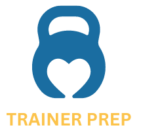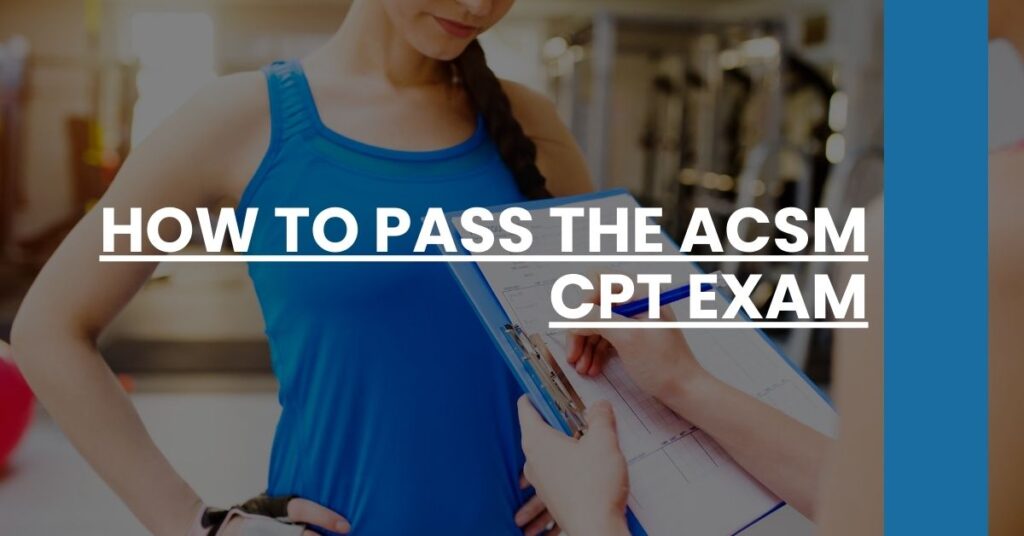Preparing for the ACSM CPT Exam can feel like a heavy lift. Many aspiring personal trainers find themselves overwhelmed by the sheer volume of materials and strategies available. You’re not alone; navigating through the complexity of the ACSM CPT Exam requires a structured approach and the right resources. That’s why we’ve crafted this comprehensive guide to help you conquer this challenge. Here’s what we’ll cover:
- How to Pass the ACSM CPT Exam with an understanding of its structure and content areas
- The best study materials and resources tailored for effective preparation
- Practical test-taking strategies to maximize your performance on exam day
Understanding the ACSM CPT Exam
Preparing for the ACSM Certified Personal Trainer (CPT) Exam begins with understanding what the exam entails. The American College of Sports Medicine (ACSM) is a respected organization in the fitness industry, and their certification represents a high standard of knowledge and expertise.
Exam Structure and Content Areas
The ACSM CPT exam consists of 150 multiple-choice questions, which you must complete in 165 minutes. The questions are spread across four primary domains:
- Initial Client Consultation and Assessment: This section evaluates your ability to gather client information, perform basic assessments, and identify risk factors. You will need to understand various assessment tools and techniques to effectively evaluate a client’s fitness level and health history.
- Exercise Programming and Implementation: Here, you are tested on your ability to design safe and effective exercise programs tailored to individual needs and goals. This includes knowledge of exercise modalities, progressions, and modifications to ensure clients achieve their desired outcomes.
- Exercise Leadership and Client Education: This domain assesses your capability in leading exercise sessions and educating clients on fitness and wellness topics. Effective communication and leadership skills are critical to motivate and guide clients through their fitness journeys.
- Legal and Professional Responsibilities: The final section focuses on your understanding of the ethical, legal, and professional standards in the fitness industry. This includes knowledge of client confidentiality, professional conduct, and scope of practice as a personal trainer.
Understanding these domains is crucial as they provide a framework for your study plan and guide your preparation efforts.
Study Materials and Resources
To effectively prepare for the ACSM CPT exam, you need access to high-quality study materials and resources that cover each domain comprehensively.
Recommended Textbooks
Two primary textbooks are recommended for ACSM CPT exam preparation:
- “ACSM’s Resources for the Personal Trainer”: This textbook provides an in-depth look at the foundational knowledge required for the exam, including exercise science, nutrition, and program design. It’s a comprehensive resource that covers all exam domains thoroughly.
- “ACSM’s Guidelines for Exercise Testing and Prescription”: This book is essential for understanding the practical applications of exercise testing and prescription. It provides detailed guidelines and protocols that are crucial for the exercise programming and implementation domain.
Online Study Guides and Flashcards
Online resources like Mometrix Test Preparation offer valuable tools such as study guides and flashcards. These resources can help reinforce key concepts and terms, making it easier to remember critical information on exam day.
Review Courses
Enrolling in a review course can provide a structured approach to your studies. Platforms like Exercise ETC offer both online and in-person courses that cover the key content areas of the ACSM CPT exam. Review courses often include practice exams, study tips, and opportunities for Q&A, which can be highly beneficial for retention and understanding.
Creating a Study Plan
A well-structured study plan is essential for success. Here’s how you can develop a comprehensive and realistic study plan:
Setting Clear Goals
Begin by setting clear, achievable goals for your study sessions. Break down the material into manageable sections and set milestones for each week. This keeps you on track and prevents last-minute cramming.
Establishing a Timeline
Create a timeline based on your exam date. Allocate more time to challenging content areas where you need additional practice. It’s recommended that you dedicate around 3-6 months for thorough preparation, depending on your familiarity with exercise science concepts.
Using Scheduling Tools
Utilize scheduling tools and apps to keep track of your daily, weekly, and monthly study goals. This helps you stay organized and ensures you cover all necessary material. ACSM provides template study schedules that can guide you through the syllabus efficiently.
Effective Study Techniques
Employing various study techniques can enhance your learning and retention.
Flashcards
Flashcards are particularly useful for memorizing key terms and concepts. Platforms like Quizlet offer pre-made flashcards tailored to the ACSM CPT exam. These can be used for quick review sessions and help reinforce information through repetition.
Practice Exams
Practicing with actual exam questions found in the Mometrix ACSM Exam Secrets study guide can help familiarize you with the exam format and types of questions. Regularly taking practice exams allows you to gauge your preparedness and identify areas that need improvement.
Group Study Sessions
Group study sessions provide different perspectives and aid in understanding complex concepts. Joining online forums or study groups on platforms like Reddit or Facebook can connect you with peers preparing for the same exam. Sharing insights and discussing challenging topics can enhance your overall comprehension.
Understanding Key Concepts
Key concepts frequently tested in the ACSM CPT exam include exercise science, program design, and client assessment. Here is a breakdown of crucial topics:
Exercise Science
Understanding muscle physiology, cardiovascular and respiratory systems, and biomechanical principles is essential. These concepts form the foundation of your ability to design effective exercise programs and assess client needs.
Program Design
Being adept at creating personalized exercise programs that cater to individual goals and fitness levels is crucial. This includes knowing how to progress exercises, modify workouts, and ensure safety and effectiveness in your programming.
Client Assessment
Client assessment involves collecting and analyzing information about your clients to create tailored exercise plans. You need to be proficient in using assessment tools and interpreting results to design programs that meet your clients’ needs and goals.
Utilizing case studies, such as those provided in the “Exercise Prescription, A Case Study Approach to the ACSM Guidelines,” helps bridge the gap between theoretical knowledge and real-world application. Applying what you learn in practical scenarios ensures you’re well-prepared for the responsibilities of a personal trainer.
With this comprehensive understanding of the exam requirements, study materials, and key concepts, you’re well on your way to passing the ACSM CPT Exam. Use these insights to structure your study plan, employ effective techniques, and gain practical experience to achieve success.
Practical Experience and Application
Importance of Hands-On Experience
Gaining hands-on experience is critical for solidifying your theoretical knowledge and understanding the application of exercise principles in real-world scenarios.
- Develop Practical Skills: Internships, volunteering, or working in fitness settings allow you to apply what you’ve learned. Interacting with clients helps you practice assessment techniques, program design, and exercise leadership.
- Build Confidence: Real-world experience can boost your confidence as you become more familiar with everyday challenges and solutions in personal training.
- Network with Professionals: These opportunities also enable you to network with industry professionals, mentors, and peers, which can provide valuable support and guidance.
Ways to Gain Practical Experience
Here are effective methods to gain practical experience:
- Internships: Look for internships at fitness centers, rehabilitation clinics, or wellness programs where you can observe and assist experienced trainers.
- Volunteering: Volunteer at local sports clubs, community centers, or health organizations. You’ll get hands-on experience while contributing to your community.
- Fitness Centers: Work part-time or freelance at gyms, recreation centers, or wellness facilities. Starting with an entry-level position can provide the practical exposure you need.
By immersing yourself in these environments, you can better understand the nuances of personal training beyond the textbook.
Test-Taking Strategies
Time Management
Effective time management is vital during the ACSM CPT exam. Here’s what you can do:
- Prioritize Questions: Quickly skim through questions and tackle the ones you’re confident about first. This ensures you secure easy points early on.
- Monitor Time: Divide your available time by the number of questions. This provides a rough estimate of how much time to allocate per question, preventing you from spending too long on any single question.
Analyzing Questions
Understanding how questions are structured will help you choose the correct answers:
- Read Carefully: Ensure you read each question thoroughly to avoid misunderstandings, as sometimes questions may have subtle nuances.
- Eliminate Wrong Answers: Narrow down your choices by eliminating obviously incorrect answers, increasing your chances of selecting the correct one.
Handling Exam Anxiety
Overcoming exam anxiety can make a noticeable difference in your performance:
- Practice Relaxation Techniques: Deep breathing, visualization, and progressive muscle relaxation can help calm your nerves.
- Stay Positive: Focus on your preparation and visualize success. Positive thinking can significantly influence your performance.
Utilizing Practice Exams
Benefits of Practice Exams
Taking full-length practice exams offers several benefits:
- Identify Strengths and Weaknesses: Tracking your performance on practice exams helps pinpoint areas needing more review.
- Familiarize with Question Formats: Regularly practicing with exam-like questions ensures you’re comfortable with the question structure and content.
- Build Stamina: Completing practice exams trains you to concentrate for the duration of the actual exam, which enhances mental stamina.
Where to Find Practice Exams
Several reputable sources provide ACSM CPT practice exams:
- ACSM Website: The official ACSM website offers free practice exams to help you prepare.
- Mometrix: Using the Mometrix study guides and practice exams can give further practice and insight.
Managing Test Day
Preparation Before the Exam
Proper preparation on test day can set a positive tone for the exam:
- Gather Necessary Documents: Ensure you have a valid government-issued ID that matches your registration name.
- Dress Comfortably: Wear clothes that allow you to sit comfortably for extended periods without distractions.
Staying Calm and Focused
Here are ways to maintain calm and focus during the exam:
- Mindfulness: Practice mindfulness techniques like deep breathing exercises to stay focused.
- Stay Hydrated: Drink water regularly, but not excessively, to keep your mind sharp.
- Eat a Balanced Meal: Have a nutritious meal before the exam to maintain energy levels.
Post-Exam: Next Steps
Understanding Your Results
After completing the exam, you will receive immediate pass/fail status:
- Score Report: Review the detailed score report provided. It highlights areas of strength and those that need improvement for future reference.
- Failed Attempt: If you don’t pass, use the score report to identify weak areas and focus your studies there for a retake.
Steps After Passing
Successfully passing the ACSM CPT Exam opens up new opportunities and responsibilities:
- Certification Maintenance: Begin the process of recertification and fulfill continuing education requirements to keep your certification active.
- Professional Development: Join professional organizations, attend workshops, and stay updated with the latest fitness trends and research.
Conclusion
Passing the ACSM CPT exam marks a significant milestone in your career as a personal trainer. With a structured study plan, effective preparation techniques, and practical experience, you can achieve success. Remember, success is a journey—embrace the process with dedication and confidence.
For a guide on passing another personal trainer exam, check out this comprehensive guide for more insights.

